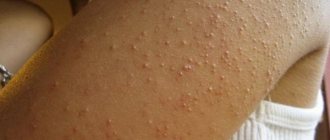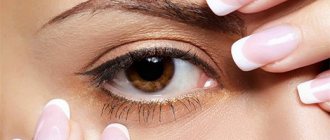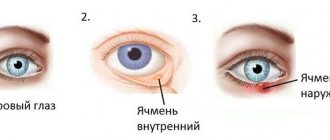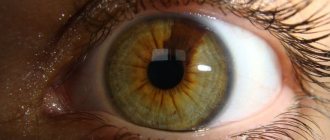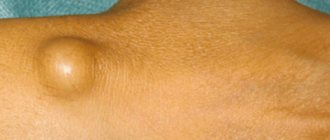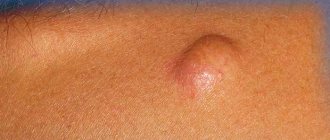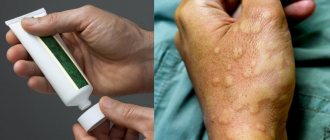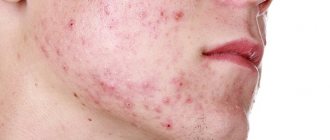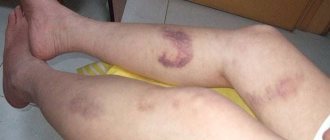The appearance of a tumor formation from the subcutaneous fat layer is called a lipoma, or wen. The neoplasm is considered benign and represents a membrane with a sebaceous filling. They occur in large numbers on the surface areas of the body. The appearance of lipoma is possible in any person, regardless of gender or age.
Wen affecting the face manifests itself as a single or multiple neoplasm. Frequent location: under or above the eye, upper and lower eyelids, inside the eye on the white membrane, in the corner of the eyes. Shows seals that are white or yellowish in color. Refers to a cosmetic defect.
What is a wen on the eyelid?
The formation of lipomas on the skin is a widespread phenomenon. Everyone is capable of encountering such a pathology. In particular, their formation on the face, near the eyes, will be unpleasant. Wen lesions most often occur in females aged 30 to 50 years, but they are often observed in men.
In appearance, these are white or yellow neoplasms with defined contours, inside of which there is a movable capsule. Lipomas on the eyelid are not an infectious disease, but it is better to remove them so that they do not create discomfort and do not provoke the formation of psychological complexes.
Often, the provoking factor for a wen near the eye is a blockage of the sebaceous gland. In some cases, lipomas may have a yellow tint. At the same time, they do not cause pain and are more likely to cause cosmetic inconvenience.
The appearance of growths near the eyes is associated with internal difficulties in the human body, therefore it is impossible to become infected with them. But it should be taken into account that such a growth can grow and affect the nerves that are located in the skin of the eye. In such a situation, it is necessary to quickly get rid of the tumors before they provoke a serious aggravation.
What causes chalazion?
In all cases, the pathological process develops in the clogged gland, but there is no clear understanding of why it is clogged.
It is possible that the composition of the fatty secretion synthesized by the meibomian gland changes. It is possible that the diameter of the excretory duct of the gland changes as a result of previous changes in the eyelid as a result of scarring after stye, prolonged wearing of contact lenses or infectious diseases of the eyelids - blepharitis. Most likely, both mechanisms initiate pathology.
Hydrogen peroxide
Peroxide is mixed in equal proportions with water, after which a cotton swab or disk is moistened in the resulting solution and applied to the area of the wen. The procedure should be repeated 2-3 times a day until the lipoma completely disappears. As a rule, recovery occurs after 1-2 weeks with constant compresses.
In conclusion, it is worth noting that wen does not pose any danger to human health, they only cause cosmetic discomfort. To eliminate them, it is not at all necessary to seek help from a beauty salon or a clinic where surgical or laser removal is performed. You can get rid of these unpleasant tumors at home using traditional medicine recipes.
How is papillomas on the eyelid removed? All about methods of treating the disease
Papilloma of the eyelid is the most common form of neoplasm.
These formations, in addition to creating a cosmetic defect, can lead to damage to the eyeball.
Below in the article we will discuss in detail the question of how to remove papilloma on the eyelid, what are the main causes, as well as what can be used to prevent the disease.
Papilloma on the eyelid occurs as a result of infection by the papilloma virus , which may not always cause discomfort to a person.
But the point is not an ophthalmological disorder, but the presence of a dermatological obstacle.
At their core, such pathologies are benign and are provoked by the entry of papillomavirus into the body.
To transmit it, contact with household items of a carrier of such a disease is sufficient , since this type of virus is opportunistic (that is, it leads to the development of the disease only under certain conditions).
The photo below shows the symptoms and signs of papilloma on the upper and lower eyelids:
Papillomas on the eyelids: causes
The main cause of papilloma is the penetration of papillomavirus into the body, which can occur for the following reasons:
- When any microtraumas form, access to the body’s circulatory system opens up for any viruses, including the causative agent of this disease.
- The development of the disease is facilitated by a decrease or weakening of the functions of the body's immune system.
- Neoplasms can arise due to systematic stress .
- Insufficient amounts of vitamins and essential nutrients can also cause the formation of eyelid papilloma.
This disease sometimes develops as a result of long-term use of antibiotic medications.
Symptoms
Symptoms of this disease are:
- Formation of growths reaching from several millimeters to several centimeters in diameter.
- Violation of the functions of closing and opening the eyelid , provided that the formations are located directly in the area of the eyeball.
- Dysfunction of the lacrimal gland , which is accompanied by profuse lacrimation that cannot be stopped.
- Overheating of the mucous membrane of the eye.
Lack of adequate treatment and untimely diagnosis of the disease can lead to the development of ophthalmological disorders such as conjunctivitis, refractive errors and blepharitis.
Provided that the papilloma occurs on the patient’s inner eyelid and has a rough surface, pain may occur.
In each specific case, the decision to remove papilloma is made by a specialist who needs to diagnose the type of disease before such procedures.
There are two types of papillomas : multiple and single , while the formations themselves can have different sizes, shapes and colors.
Also, such pathologies
can have low and high oncological activity .
Otherwise, pathologies grow quickly, and the purpose of the removal method depends on the decision of the attending physician, since sometimes conservative therapy is sufficient (although in most cases surgical intervention is required).
Papillomas on the eyelid in children
Very often, a similar problem occurs in children , and most often children's papillomas form on the eyelash edge.
The main danger of such ailments is that a child , unknowingly, can damage the integrity of the papilloma when rubbing and combing it .
When treating such a disease in adults, the use of traditional medicine methods is allowed.
But treating pathology in a child with this method is contraindicated , since many drugs can cause swelling, pain and pain.
In children, such formations can go away on their own after several months, so for young patients, surgical intervention for diseases of this kind is an exception.
Danger of pathology
There are a number of reasons why eye papillomas need to be removed:
- Such pathologies may be signs and secondary symptoms of malignant tumors.
- In some cases, these formations lead to the functionality of the visual apparatus , as they block the field of view.
- If there are large growths, complete loss of vision is possible , as they block the view.
How to remove papilloma on the eyelid?
Modern medicine allows you to remove papilloma on the eyelid in several ways, and in most cases the prognosis is favorable.
Laser removal
Laser removal is the optimal solution in this case, as it allows the procedure to be carried out without leaving any traces (scars, cicatrices or adhesions) in the surgical area.
Removal occurs at the level of the dermal (deep) layers, which involves complete elimination of the defect without the risk of the formation of cancerous tumors .
Healthy tissues are not injured due to the ability to fine-tune the laser beam (we are talking about its intensity and focusing).
The operation takes only a few minutes, although it is preceded by a lengthy diagnosis.
During the intervention, the person does not feel any pain , but if pain occurs, the surgical site can be treated with local anesthetics.
The laser beam is used for non-contact intervention: the instrument does not have direct contact with the patient’s eye, which guarantees not only comfort, but also a reduced risk of infection of the conjunctiva .
Considering that the operation takes place under completely sterile conditions, the likelihood of contamination is extremely low.
Surgical removal
This is a rather risky method in which complete elimination of the defect is not guaranteed .
In addition, the patient is familiarized in advance with the conditions of the operation, one of which is the presence of a scar after the surgeon’s work.
From a cosmetological point of view, this is a fairly obvious effect, which is also difficult to remove, so surgical intervention is considered a last resort in this case.
Cryodestruction
This method involves cauterizing the papilloma with liquid nitrogen .
Despite the fact that the method is considered quite crude from a technical point of view, it is relatively safe.
In addition, thanks to deep treatment and eradication of the base of the tumor, cryodestruction is considered to be the most effective and in almost all cases guarantees the absence of relapse of the pathology.
In this case, there is only one contraindication: the so-called “hanging mole”, which can form at the very edge of the eyelid, since in this case there is a risk of damage to the mucous membrane of the eyeball.
Folk remedies for papilloma on the eyelid
Traditional methods for eradicating such a disease are far from the most effective method.
Moreover, each method requires prior consultation with your doctor.
Considering that we are talking about the organs of vision, which require the most careful treatment, the following safe methods are recommended:
- A herbal mixture of horsetail, nettle, plantain, dandelion root and lemon balm is mixed in a ratio of 20 grams of each herb in dried form. The composition is poured with warm boiled water, after which it is kept in a water bath for ten minutes to steam. After this time the container with the product is infused for three hours (the container should be covered with a thick cloth or towel).
The finished composition is filtered through cheesecloth and consumed in the amount of three tablespoons about half an hour before each meal for a week. - Herself papilloma can be treated with a herbal infusion based on celandine and walnut leaves.These are quite caustic plants, so the dosage must be strictly observed. Each ingredient must be taken in the amount of a third of a tablespoon and the mixture must be filled with 100 grams of pure medical alcohol.
This solution should be infused in a dry, dark place for a week. Processing of built-up produced with a cotton swab dipped in the solution, two to three times a day for 21 days.The method is not recommended if the formation is located in close proximity to the conjunctiva.
- Juice is extracted from any plants and fruits (except citrus fruits) , which is also applied to the growth using a cotton swab or swab. Treatment is carried out at least twice a day .
It should be noted that such methods may not bring any effect, so they should not be considered as the main course.
Application of ointments
Different types of ointments are used to treat eyelid papillomas:
- Antiviral ointments, the main one of which is oxolinic.This is an antiseptic drug that has virtually no contraindications and can even be used to treat growths in children.
Preferably do not use this product more than three times a day, since as a result of frequent use, addiction may occur, and as a result, a lack of effectiveness of the drug.In such cases, the course of treatment is adjusted, and a stronger medication may be prescribed.
This could be Viferon (an ointment based on interferon, which has antiviral properties).
The product is applied to pathological areas in accordance with the instructions for use, but usually the procedure is carried out no more than three to four times a day . The course of treatment is seven days, but when using this remedy, both recovery and complete lack of effect can be observed).
- Ointments containing natural ingredients. In this category, the main drug is Vishnevsky ointment , which is applied in small portions to the formations. The procedure should be performed in the morning, after waking up, and before going to bed. Such products should not be used for a long time, since swelling and various types of rashes may appear as side effects of use.
- Preparations based on trace elements and acids, including salicylic ointment . This is a gentle remedy that destroys bacteria, but will not help get rid of papilloma itself.
Although such drugs have undergone clinical trials, they may have side effects.
Therefore, before using them, you should carefully read the instructions and consult with your doctor.
Disease prevention
The simplest rules that can be followed to prevent the appearance of papillomas are:
- timely treatment of the slightest wounds , injuries and scratches in the eye area;
- maintaining personal hygiene rules;
- maintaining the body's immunity at the proper level.
This will help preserve your eyesight and prevent the appearance of cosmetic defects.
In this video you will see how to remove papilloma on the eyelids at home:
Papilloma of the eyelid is the most common form of neoplasm, which, in addition to creating a cosmetic defect, can lead to damage to the eyeball.
Modern medicine makes it possible to remove such defects in several ways, and in most cases the prognosis is favorable .
Was the article helpful?
Source: https://zrenie1.com/bolezni/papillomi-vek.html
Kinds
Lipomas on the eyelids are classified based on the composition of the growth. Thus, in medical practice there are:
- Angeolipoma. It is characterized by a large number of vessels.
- Diffuse. There is no connective tissue membrane.
- Fibrous. A growth in which connective tissue grows.
- Painful. Multiple wen, accompanied by sharp pain.
- Ossified. A fatty tissue that contains bone tissue.
- Petrified. Includes calcium deposits.
- Lipoma on the leg. A neoplasm, the formation of which was carried out over a long period of time and has reached a large size, forms a skin stalk.
- Soft. Lipoma, which has a soft consistency due to the predominant content of adipose tissue.
- Dense. A characteristic feature is an increased concentration of connective tissue, as a result of which the wen has an elastic consistency.
What is a wen
Doctors call this formation under the skin a lipoma. This is not a pimple, but a benign tumor consisting of a capsule filled with yellowish fat. Lipomas on the eye are characterized by the following features:
- consistency soft to the touch;
- mobility of the tumor, which, like a ball, easily rolls under the skin;
- the wen does not become inflamed and does not suppurate;
- does not cause burning, pain, itching.
If the wen near the eye grows strongly and compresses the nerve receptors, painful sensations appear. Sometimes a lipoma does not increase over many years, and sometimes it decreases and disappears on its own. More often, the location of the wen on the eye is the upper eyelid, less often - the lower.
At first, the lipoma is very small, like a convex dot. As the tumor grows, it can turn into a lump, reaching a size of several centimeters. Most people develop single lumps on the eye, but formations can also grow in groups. In this case, doctors diagnose multiple lipomatosis.
In some sources, lipoma is synonymously called atheroma. Although they are very similar in appearance, this is not true. Atheroma is also an accumulation of fats, but does not arise due to tissue growth, but due to blockage of the sebaceous glands. In addition, this is a different type of tumor - a cyst. Atheromas can become inflamed.
During puberty, adolescents often develop dense white wen - milia - around the eyes. The appearance of such neoplasms is caused by cell proliferation due to blockage of actively functioning sebaceous glands. In addition, milia under the eyes may indicate dry skin, inept use of cosmetics, and disorders in the digestive tract.
Wen on the eye is a safe phenomenon. Cases of lipomas degenerating into cancerous tumors are extremely rare. However, it is necessary to eliminate the slightest risk, so it is better to get rid of such tumors immediately. In a child, a wen that impedes the growth of young tissues can be eliminated from the age of 5.
Classification of lipomas
Wen that appears on the eyelids is usually classified according to location:
- on the inner eyelid
- on the upper eyelid (most common),
- on the lower eyelid.
Experts most often recommend removing lipomas that appear on the inner eyelid. Neoplasms on the upper eyelid, if large enough, can interfere with vision and also require removal. Pathologies in the lower eyelid cause psychological discomfort, as they are the most noticeable.
What it is
Papilloma on the mucous membrane of the eye or epithelium is a benign growth formed as a result of abnormal division and enlargement of skin cells.
Externally, warts are flat, similar to a pimple, a mushroom, hanging on a thin stalk. In most cases, polyps are small, but sometimes large defects several centimeters in diameter are detected.
Extremely unpleasant sensations are caused by papillomas on the eyelids, near the eyelashes, eyes or on the mucous membrane of the organ of vision.
In these places, growths interfere with normal blinking and disrupt the hydration of the eyeball. This leads to a deterioration in visual acuity and the development of various ophthalmological pathologies.
Causes
The causes of lipomas on the eyelids have not been fully established; they appear suddenly and tend to gradually increase in size. The main factors in the formation of growths include improper metabolism.
It is a known fact that lipomas can be inherited. When parents have similar growths, there is a possibility that they will also appear in their children.
In such a situation, the neoplasm will appear at a fairly young age. The growths tend to develop slowly and often go undetected for a long time.
On this topic
How to quickly cure inflammation of the wen
- Inna Viktorovna Zhikhoreva
- September 27, 2020
Factors that contribute to the formation of wen:
- Increased cholesterol within the body.
- Inadequate care for sensitive facial skin, which causes clogged pores.
- Using cosmetics that are not suitable for a particular skin type.
- Failure of bile outflow.
- Diabetes .
- Regular overeating, which leads to metabolic disorders and the growth of adipose tissue.
- Deterioration of the immune system.
- Diseases of the genitourinary system.
- Metabolism failure .
- Hormonal disorders.
- Diseases of the endocrine system.
- Inactive lifestyle .
The above circumstances can cause active growth of adipose tissue, which will provoke the formation of lipomas on the eyelids.
Diagnosis and treatment of chalazion
The diagnosis can be made “by eye”, but only an ophthalmologist can accurately determine it. The clinical picture of the disease is so typical that it does not cause difficulties. Only in the presence of large and often recurrent formations may it be necessary to exclude tumor growth.
Often, within 2–3 weeks, a small chalazion disappears on its own, the dense secretion stretches the excretory duct of the meibomian gland and the contents fall out.
Conservative treatment consists of using dry compresses on the eyelid, antibacterial drops in the eye and ointments containing hormonal and absorbable medicinal components on the eyelids.
If conservative treatment is not effective, then surgical removal is resorted to. The operation is performed on an outpatient basis and under local anesthesia. Healing occurs within a week.
Often re-occurring chalazions, as well as multiple formations, require identification of the cause leading to the pathology, and not only local treatment - permanent treatment. It just seems that all eye diseases come exclusively from the eyes and in isolation from other body systems; a person is a complex biological system and requires a serious approach, which is individually implemented at the Medicine 24/7 Clinic. Sign up for a consultation: +7 (495) 230-00-01
Symptoms
Neoplasms near the eyelids do not cause pain and do not cause the patient any difficulties, in addition to psychological worries regarding appearance.
It is possible to detect a wen by the following signs:
- The growth is characterized by mobility and soft consistency.
- There is no painful sensation during pressing.
- The neoplasm can stop or accelerate in development. It is characterized by extreme mobility, but it is not recommended to touch it constantly.
Regular touching and pressing can cause destruction of the capsule where the adipose tissue is located, which will harm the general condition. Also, such an action can provoke a massaging effect and increase blood flow, which causes accelerated development of the wen.
A cluster of lipomas that are located close to each other is called lipomatosis. When it is associated with painful sensations – painful lipomatosis.
What complications are possible?
Sometimes there is a breakthrough of the contents towards the eyeball or into the tissue of the eyelid.
A long-term local process can transform into a cyst. Unlike barley, a chalazion is located away from the edge of the eyelid.
Cases have been described when chalazion was recognized as the cause of skin cancer of the eyelid, because with chronic inflammation, cells divide intensely and quickly and are capable of straying from their normal program.
A large formation that persists for a long time can cause deformation of the eyeball, damage the cornea, contributing to the development of astigmatism, and when pus breaks out, conjunctivitis occurs.
Take care of yourself, book a consultation now
Diagnostics
In some cases, lipomas disguise extremely dangerous diseases, including malignant neoplasms. Diagnosis of a wen is simple. Often an external examination is enough for a specialist to make an accurate diagnosis.
Types of diagnostics:
- Visual inspection. Lipoma on the eyelid is usually small (3-7 mm in diameter). The growth is milky or yellow in color, round in shape, often irregular.
- Probing. The fat has characteristic mobility. In the process of pressing on it, it easily moves under the skin. There is no pain at this time.
- Clinical diagnosis. It is carried out infrequently. Includes a study of the amount of hormones in the body, a general blood test and its biochemical composition.
- Cytology. A fragment of adipose tissue that is removed from the tumor is sent for diagnostics in order to exclude a malignant tumor.
Detecting a wen on the eyelid does not cause difficulties for the doctor.
Which doctor should I contact?
To eliminate a wen on the eyelid, you will need to consult several specialists: an ophthalmologist, a dermatologist, a surgeon and an endocrinologist.
If the tumor is small and does not cause discomfort, then it can be removed at an aesthetic medicine center or a dermatovenerological dispensary.
This procedure is also carried out in cosmetic clinics and ophthalmology centers. With extensive damage, additional diagnostics are required. Full surgical intervention is carried out only in a surgical hospital.
Wen on the eyelids is not only an aesthetic problem. They may increase in size and become inflamed. If the formation is small, drug therapy will be sufficient to eliminate it. Removal of a large lipoma is carried out using one of the surgical methods.
Diagnosis methods
If you notice the first signs of illness, you should visit several doctors at once. A cosmetologist or dermatologist will help identify the nature of the pathological formation, and an ophthalmologist will tell you about its effect on vision. Based on the examination data and initial conversation with the patient, many specialists can already draw a conclusion about the nature of the disease.
Don’t forget that before going to the doctor you shouldn’t paint your eyes or disguise the wen with foundation and powder. Based on my practice, I can say that most of these formations could be detected at an early stage if patients came for examination with a clean face. Decorative cosmetics significantly impede visibility and lead to errors.
What methods are used to confirm the diagnosis:
- examination of skin scrapings (detection of pathological microorganisms);
- bacterial culture of the eye discharge (helps determine the presence of pathogens and select the drug necessary for treatment);
- biopsy of the formation if it is large (used to distinguish lipoma from other tumors: the presence of atypical cells indicates the malignancy of the process).
Table: differential diagnosis of wen and other diseases of the eyes and eyelids
| Comparative characteristics | Wen | Tumor formation | Conjunctivitis | Barley | Demodectic lesion of the eyelids |
| Pain on pressure | Absent if there is no secondary infection | Occurs only in late stages of disease development | Slight, appears when blinking | Severe, acute pain | Not typical |
| Changes in the skin and mucous membranes | Formation of whitish or yellow dots, gradually increasing in size | The appearance of a foreign formation in the eyelid area, which makes it difficult to see | Redness of the mucous membrane of the eyes, profuse lacrimation even with slight irritation | Redness, swelling, the appearance of a pathological bulge with a white lump in the center | Peeling and massive rejection of the smallest skin flakes, formation of crusts and plaque on the eyelashes |
Photo gallery: what other eyelid pathologies look like
Conjunctivitis typically affects the mucous membranes
The tumor is characterized by gradual growth and ulceration
With demodicosis of the eyes, crusts form on the eyelashes
Barley is characterized by redness of the skin in the area of formation
Pinguecula of the eye: photo, treatment with drops and folk remedies, reviews after removal
The pinguecula is a yellowish neoplasm that slightly rises above the level of the conjunctiva. As a rule, it is localized from the inner corner of the eye. It grows slowly.
Pinguecula is a fairly common phenomenon, especially in older people. At the same time, its appearance is not reflected in the work of the visual analyzer.
There is a popular belief that a pinguecula can become malignant, that is, develop into a malignant neoplasm. This is wrong. In fact, it is only a change in tissue due to excess protein and cholesterol . Thus, it does not pose any danger to the body and can be considered a cosmetic defect.
What it is?
A pinguecula of the eye is a small formation of white or yellowish color, which most often occurs on the side of the bridge of the nose or near the cornea of the eye. Such growths can appear on both sides at once. If you notice a small bump on the eyeball, do not worry, because this disease does not pose a great danger and is a benign neoplasm.
Consult an ophthalmologist to confirm the diagnosis and prescribe the optimal treatment method.
| Timely treatment will prevent the growth of a nodule on the sclera and help combat discomfort or unpleasant symptoms. |
Signs
The disease is accompanied by the following pain symptoms:
- pain and burning sensation when blinking;
- dry eyes;
- swelling of the mucous membrane of the eye;
- redness of the eyelid and eyeball;
- tearfulness of the eye;
- sensation of a foreign body in the eye.
It is noteworthy that this disease occurs quite rarely in children, since it is considered to be age-related. But there is an exception when children spend a long time in the sun without observing safety precautions (do not wear hats or sunglasses).
A growth on the eyeball (pingueculus) is a type of benign formation that develops on the mucous surfaces of the eye shell due to excessive intake of protein compounds and fat cells into the body. The main location of this pathology is the corneal region of the eye or the plane of the conjunctiva.
Typically, such growths are either yellowish or completely transparent. Depending on the initial shade of the pinguecula, it is possible to determine the type of growth and why it was formed.
A growth on the surface of the eyeball, which has a transparent color, occurs against the background of an oversaturation of the body with protein, which can be triggered by excessive consumption of protein-rich foods.
In many cases, patients with a transparent pinguecula are additionally diagnosed with urolithiasis of the kidneys or bladder. Without appropriate medical manipulations, the transparent growth on the eye will not disappear or resolve on its own.
Causes of the disease
The reasons may be different; the mechanism of development of the disease and the appearance of undesirable symptoms depend on them. Let's look at some of them:
- Age. Most often, a pinguecula begins to form in older people as a result of mutations in conjunctival tissue due to improper metabolism. An aging body begins to poorly absorb dietary fats and proteins, and their excess leads to mutations and the formation of translucent bulges on the sclera of the eyes.
- Climatic conditions. Heat and dry air often affect the development of small bumps on the whites of the eyes. In warm countries, this disease is more common than in areas with a humid climate.
- Ecology and working conditions. People living in areas with poor environmental conditions or working in difficult conditions (pollution, smog, dust and strong wind, etc.) often suffer from this disease.
- The influence of ultraviolet and infrared radiation. Constant exposure to the sun without protective glasses can lead to the formation of pinguecula of the eyes.
- Pre-existing eye disease. The chronic form of conjunctivitis can trigger the development of a growth on the cornea.
In rare cases, pinguecula is a consequence of other complex diseases in the human body (Gaucher disease, for example) and in such cases relapses and reappearance of tubercles on the sclera may occur
Causes of growth
A pinguecula is a small and elastic formation that is localized in the area of contact between the cornea and conjunctiva. It is a consequence of hyaline tissue degeneration.
As a rule, a pinguecula appears in the area of the inner edge of the cornea. Moreover, it often develops in both eyes at once.
In most cases, elderly people complain about the occurrence of this pathology. Despite the fact that this disease is very common , people do not often go to doctors.
There is an opinion that prolonged wearing of contact lenses leads to the development of pinguecula. In fact, this is a myth, and no such facts have been established.
Pinguecula is a sign of aging of the conjunctiva, which is why it tends to occur
in older people .
In addition to age-related characteristics, occupational factors that constantly have a negative effect on the eyes can lead to the appearance of this pathology. It could be smoke, wind, dust.
Often, the development of pinguecula is favored by a hot and dry climate . Also, the causes of the disease include constant exposure to ultraviolet rays.
That is why this pathology is very often diagnosed in people who spend a long time on the street.
Symptoms of pathology
At the beginning of its development, the disease is asymptomatic, only a small light compaction on the conjunctiva is noticeable. A person may not notice it for a long time, and will pay attention only when the tumor significantly increases in size, inflammation begins, and other symptoms appear:
- The onset of the inflammatory process will entail visual changes (hyperemia of the conjunctiva in the area of the growth)
- Dry eye syndrome may develop
- Sometimes patients complain of discomfort while blinking
- Patients often feel the presence of a foreign object or speck in the eye; in this case, the pinguecula is already increased in size and can cause constant tearing
- Patients note increased sensitivity of the eyes in bright light, strong wind, dust and suspended particles in the air
| Symptoms of the disease may not appear for many years, so a person will not immediately turn to an ophthalmologist if he is not concerned about an aesthetic problem. When inflammation has already begun, you should consult a doctor in order to prevent the condition from worsening and prescribe treatment. |
Diagnosis of the disease
After a routine examination of the patient, the ophthalmologist makes a diagnosis, but to fully study the pathology, there are special diagnostic methods that help to examine in detail the ocular tissue and vascular anomalies. The doctor can use the following analysis methods:
- You can study the fluid of the lacrimal canal and detect abnormal components in its composition using the Ferning test.
- Fluorescein angiography examines the lining of the eye, the health of the optic nerve, the condition of the blood vessels, and changes in the retina. The procedure is carried out using a special contrast agent, which makes it possible to study the smallest vessels and identify abnormalities.
- The biomicroscopy method allows the doctor to examine the patient’s eyeball (the condition of the lens and conjunctival tissue, the health of the iris and cornea). Dystrophic pathologies and possible inflammation that begins in the tissues are identified.
- One of the most effective methods for correctly diagnosing the disease is optical coherence tomography, which accurately determines the condition of the eye shell and the depth of growth of the lump into the internal structure of the organ. This way the optimal treatment method is determined.
| The diagnostic method and additional examination are chosen by the ophthalmologist in accordance with the results of the examination, medical history and complaints of the patient. |
Is this dangerous for a person’s vision and which doctor should I contact?
Pinguecula extremely rarely changes the structure of its cells from a benign etiology to a malignant form of the neoplasm. Still, a certain amount of risk always exists.
Based on this, patients who have a genetic predisposition to cancer in their family are recommended to undergo laser removal of the growth, as well as undergo diagnostics of the body to identify metabolic disorders.
In general, the pinguecula does not affect the quality of vision, since in most cases it is located too far from the pupil and does not affect the visibility of the visual field.
If you find a foreign growth of yellow or transparent color on the surface of the white of your eyeball, it is recommended to visit an ophthalmologist for advice.
The doctor will conduct a visual examination of the organ of vision and, if necessary, write a referral for tests and a comprehensive examination using special medical equipment.
Only after this the patient receives a prescription to take conservative medicine medications or is offered to undergo laser removal of a benign tumor.
Treatment of pinguecula
If pinguecula of the eye is diagnosed, any procedures are prescribed by an ophthalmologist only if the patient has complaints. The benign nature of the formation and the rather slow progression of the disease, which often occurs without symptoms, does not pose a danger to a person and does not affect the quality of his life.
Treatment is necessary if pingueculitis develops and symptoms of the disease appear. Most often, therapy will be conservative, but sometimes surgery is required to remove a lump that has greatly increased in size.
Conservative therapy
This treatment involves the use of medications in the form of drops to moisturize the mucous membrane and eliminate inflammation. The following medications will help avoid complications and eliminate symptoms:
- For moisturizing, ophthalmologists recommend drops “Hilo-Komod”, “Ophtolik”, “Oxial”, “Lacrisify”, “Systane”, “Artificial tear”, etc.
- To relieve inflammation, antibacterial drops “Tobradex”, “Tsipromed”, “Diclofenac”, “Tobrex”, “Maxitrol”, “Vigamox”, “Dexomethasone”, “Sofradex”, etc. are recommended.
If an inflammatory process is being treated, it is necessary to choose glasses and temporarily abandon contact lenses, which can aggravate the patient’s condition.
Pinguecula removal surgery
Indicated only to eliminate a cosmetic defect that bothers the patient, or in case of mutation of the pinguecula and its transformation into pterygium. It can be carried out traditionally or performed with a laser. Rehabilitation is much faster. This is a painless removal of the formation, which provides anesthesia using Innocaine.
The operation lasts about 15 minutes, after which the patient can go home. For the first time, the eye is covered with a bandage that protects from dust and sunlight. Laser removal of existing growth is the safest method, guaranteeing a good result.
Treatment with traditional methods
| You can improve the patient’s condition and remove minor symptoms using folk remedies. Before this, you need to consult an ophthalmologist to prevent undesirable effects. |
The following will help strengthen blood vessels and relieve discomfort:
Compresses with chamomile
To do this, take 1 tbsp. l. flowers and pour 200 ml of boiling water, leave to infuse for half an hour. After this, pieces of bandages or cotton pads are soaked in the broth and left on the eyes for 25–30 minutes. The procedure is repeated 2-3 times a day.
Treatment
Lipoma therapy should be carried out under the supervision of a specialist. In some cases, patients try to get rid of such a tumor themselves and pierce it, and then squeeze it out.
On this topic
How to quickly remove a wen
- Inna Viktorovna Zhikhoreva
- September 25, 2020
This can put their health at risk: due to the lack of sterile conditions, any infection can penetrate inside the body, scars form on the skin, the elimination of which will take quite a long time. This is especially unpleasant in situations where the growth is located on an exposed part of the body, such as the eyes.
There are 2 ways to eliminate these tumors: medication and surgery.
Drug therapy
Before starting treatment for lipomas, it is imperative to find out the recommendations of a specialist. Only a qualified doctor will select the optimal drug therapy.
Drug treatment involves the introduction of special medications into the growth that prevent the active growth of adipose tissue. However, the result of such therapy will be noticeable only after 2 months after the manipulation, and the procedure itself will not help to completely get rid of the disease.
Lipoma on the eyelid can be removed using compresses, which require Vishnevsky ointment. This remedy is characterized by an anti-inflammatory effect and promotes the rapid removal of the contents of the growth outward. Vishnevsky ointment effectively counteracts soft and hard lipoma.
Ichthyol ointment is also effective for this disease. It is effective in eliminating a variety of skin diseases and damage. Promotes speedy recovery. It also aims to bring pus to the surface. However, it is advisable to use such therapy when the dimensions of the growth are no more than 2 cm.
Removal
In most situations, lipomas on the eyelids can only be eliminated through surgery. This method is the most reliable in fixing the problem. At the moment, the following methods are widely used:
- Light spot liposuction. The use of a special substance injected into the tumor using a thin needle. When the contents of the capsule soften, it is removed by pumping out.
- Traditional surgical intervention. Local anesthesia is used. Specialists carefully remove the lipoma from under the skin, making a neat and small incision. It is optimal to carry out such a manipulation in eye surgery, since under the skin of the eye there is a large number of nerve endings that can be damaged, therefore it is more advisable for specialized specialists to do this.
- Chemical removal of growth. Lipoma near the eyelid can be eliminated using special chemicals. It has the same principle of action as liposuction. The main task of specialists in such a situation is to soften the hard contents of the fat capsule, after which it will be easier to remove it.
- Laser surgery. An effective method for getting rid of wen on the eyelids. The advantages of using a medical laser are the speed of the procedure, its painlessness and short recovery time.
On this topic
What threatens a wen on the back?
- Irina Nasredinovna Nachoeva
- September 3, 2020
When the growth has changed significantly in size or is marked by active development into the tissues, specialists send it for diagnostics in order to exclude malignancy. In certain situations, it is necessary to undergo additional tests that will allow a more accurate assessment of the patient’s condition.
After the operation, the doctor makes sure that nothing has grown inside the tissue. If anything remains, there is a possibility of secondary formation of lipoma on the eyelids. Therefore, a specialist must carefully check everything and make sure. The recovery period lasts 3-7 days. This duration is due to the fact that the area where the growth is removed is very sensitive and tender. In this regard, it is necessary to proceed with caution.
Varieties
The presence of a wen on the eye or eyelid causes discomfort; they try to remove the tumor as soon as possible. The method of therapy is used depending on the type, health status, and appearance of the patient’s skin:
- Xanthelasma - a wen forms on the eyelids, white, rarely yellowish. It has a flat appearance, with bubbles and irregularities along the edges. It forms on the epidermis on the inner side of the corner of the eye and grows on the sensitive layer of the skin. Most often, a single formation is observed, but the formation of a wen is possible in various parts of the body. Its appearance indicates disturbances in the activity of fat metabolism.
- Milia are multiple white small growths covering the dermis of the face. Observed below the eyes, on the skin of the eyelids.
Milia in the eye area
Formation occurs on the upper part of the skin, where keratin is located. Lipomas are small, do not exceed more than two mm, compacted, with precise boundaries. The inner layer consists of clusters of cells of a layered appearance.
- Natural lipoma - in appearance it is characterized by a protruding part above the skin of gray or pale yellow color. The formation is moving, not fixed, and moves when palpated.
- A dermoid cyst has a characteristic round appearance and a yellow tint. It is formed by a single or double capsule shell filled with fat cells. It poses a danger to eye health; the lens may become clouded, and the clarity and range of vision may decrease.
Sometimes warty formations appear on the face around the eyes - this is a type of papillomas. The formations are considered benign, characterized by a thread-like form, and are invisible for some time during development. They appear as fuzzy balls, contribute to changes in the skin, sizes do not exceed 1 cm.
How to remove wen at home - folk remedies
Often they try to squeeze out a lipoma on the eye like an ordinary pimple. This is a very dangerous method! It is easy to infect the wound, and if a capsule remains under the skin, the appearance of a new wen in the same place is inevitable. The following traditional medicine methods are safer:
- In order for the lipoma to open, you should lubricate the tumor on the eye 7-10 times a day with Kalanchoe juice.
- Mix the gruel of 5 chestnut kernels, obtained in a blender, with 10 ml of aloe juice and 20 ml of honey. Apply the product on a cotton swab to the eye every day and hold for 15-20 minutes. Store the mixture in the refrigerator.
- Infuse 25 g of oak bark in 100 ml of warm vodka for 3 days, then filter. Lubricate the lipoma with this tincture 6-8 times a day for a week.
It is best to lubricate a healing wound with Levomekol ointment. It is dangerous to get rid of wen with the juices of celandine, garlic, and onions. Do not burn lipomas on the eye with iodine or brilliant green - it is easy to get burns!
Application of traditional methods
Wen on the eyelid is considered a common phenomenon. Some patients try to get rid of lipoma. They try:
- pierce or squeeze out,
- do cauterization using iodine or brilliant green;
- apply herbal compresses and wipes.
A benign nodule of small volume is eliminated using traditional folk methods. They are aimed at improving blood circulation around the tumor and if the lipoma is small:
- An effective method is the use of celandine juice. It is used to remove growth in areas where hair does not grow. Not suitable for therapy around the eyes. The plant is poisonous and the juice helps the formation of skin ulcers. Through the affected areas, you can remove the fat content by using a compress with aloe, Vishnevsky ointment or plantain leaves.
- Garlic helps speed up blood flow. The plant has an irritant effect and, when applied to the skin, stimulates blood flow to the tissues. The garlic clove is turned into a homogeneous mass, a couple of drops of sunflower or flax oil are added to it. The drug prepared in this way is rubbed daily at the site of the tumor.
- Hellebore root tincture helps cleanse the body and independently absorb fatty deposits. The dried plant is turned into powder, boiling water is added and infused. The strained infusion is drunk every day. The therapy is long, for the result to be noticeable, you need to take the medicine for about a year.
It is advisable to get rid of wen at home using traditional medicine only after consulting a doctor! Self-treatment will lead to a worsening of the condition of the node and contribute to its development into a malignant tumor.
To prevent lumps from bothering you in the future, you should get rid of bad habits, avoid overcooling, eat well, and consult a doctor promptly as soon as neoplasms appear.
Prevention
To prevent lipomas from forming on the eyelids, you should be careful about your own health. It is necessary to saturate your diet with plenty of vitamins to maintain your immunity.
This will enable the patient to feel better. With proper nutrition, wen will not appear. You need to balance your menu and eat only fresh and healthy foods. Limit consumption of fatty and smoked foods.
You also need to reconsider your daily routine. You should add more walks in the fresh air, balance your sleep and rest schedule.
